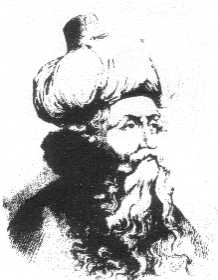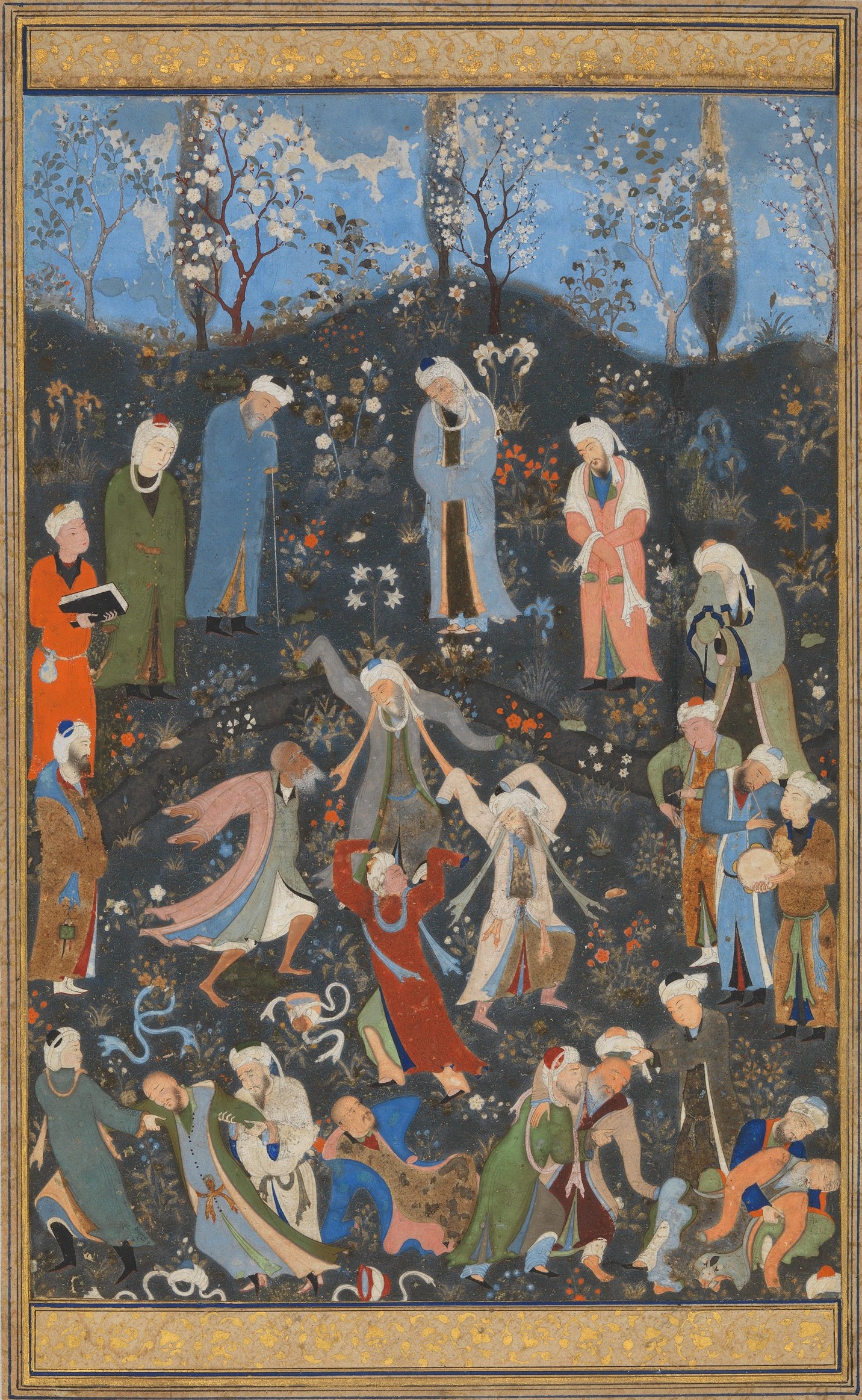|
Sufism In Spain
Sufism in Spain was practiced in Al-Andalus mainly in the 9th century. Although it did not reach the extent of other lands, it would strongly influence Islam in Spain and Iberian culture in general. History The first spread of Sufi spirituality can be traced back to Ibn Masarra (883-931), who wrote works in the line of Mutazilism and Batimi Sufism. His text are lost and what is known about them is due mainly to the work of a later disciple, Ibn al-A'rabi (1165-1240). The next decades saw a growth of Sufi movements in Al-Andalus, although they did not become organized in tariqa as in other lands, but in smaller groups centered around a master, without a initiation ritual and often without calling themselves Sufi. One of the first true schools formed was that of Ibn al-Arif (1088-1141), although it would be with Abu Madyan (116-1198), who performed a synthesis of Sufi thought of his time, including Oriental, Andalusi and Magrebi, that Sufism would truly blossom in Spain. His infl ... [...More Info...] [...Related Items...] OR: [Wikipedia] [Google] [Baidu] |
Sufism
Sufism ( ar, ''aṣ-ṣūfiyya''), also known as Tasawwuf ( ''at-taṣawwuf''), is a mystic body of religious practice, found mainly within Sunni Islam but also within Shia Islam, which is characterized by a focus on Islamic spirituality, ritualism, asceticism and esotericism. It has been variously defined as "Islamic mysticism",Martin Lings, ''What is Sufism?'' (Lahore: Suhail Academy, 2005; first imp. 1983, second imp. 1999), p.15 "the mystical expression of Islamic faith", "the inward dimension of Islam", "the phenomenon of mysticism within Islam", the "main manifestation and the most important and central crystallization" of mystical practice in Islam, and "the interiorization and intensification of Islamic faith and practice". Practitioners of Sufism are referred to as "Sufis" (from , ), and historically typically belonged to "orders" known as (pl. ) – congregations formed around a grand who would be the last in a chain of successive teachers linking back to Muham ... [...More Info...] [...Related Items...] OR: [Wikipedia] [Google] [Baidu] |
Arabist
An Arabist is someone, often but not always from outside the Arab world, who specialises in the study of the Arabic language and culture (usually including Arabic literature). Origins Arabists began in medieval Muslim Spain, which lay on the frontier between the Muslim world and Christendom. At various times, either a Christian or a Muslim kingdom might be the most hospitable toward scholars. Translation of Arabic texts into Latin (mostly of works on mathematics and astronomy) began as early as the 10th century, major works dates from the School of Toledo, which began during the reign of Alfonso VII of Castile, (1105–1157). Translations were made into medieval Latin or Church Latin, then Europe's ''lingua franca'', or into medieval Spanish, which was the vernacular language of that time and place. Early translations included works by Avicenna, Al-Ghazali, Avicebron, etc.; books on astronomy, astrology, and medicine; and the works of some of the Ancient Greek philosophe ... [...More Info...] [...Related Items...] OR: [Wikipedia] [Google] [Baidu] |
Sufism In Europe
Sufism ( ar, ''aṣ-ṣūfiyya''), also known as Tasawwuf ( ''at-taṣawwuf''), is a mystic body of religious practice, found mainly within Sunni Islam but also within Shia Islam, which is characterized by a focus on Islamic spirituality, ritualism, asceticism and esotericism. It has been variously defined as "Islamic mysticism",Martin Lings, ''What is Sufism?'' (Lahore: Suhail Academy, 2005; first imp. 1983, second imp. 1999), p.15 "the mystical expression of Islamic faith", "the inward dimension of Islam", "the phenomenon of mysticism within Islam", the "main manifestation and the most important and central crystallization" of mystical practice in Islam, and "the interiorization and intensification of Islamic faith and practice". Practitioners of Sufism are referred to as "Sufis" (from , ), and historically typically belonged to "orders" known as (pl. ) – congregations formed around a grand who would be the last in a chain of successive teachers linking back to Muham ... [...More Info...] [...Related Items...] OR: [Wikipedia] [Google] [Baidu] |
Abu Al-Abbas Al-Mursi
Al-Mursi Abu'l-'Abbas (1219 in Murcia – 1287 CE) ( ar, المرسي أبو العباس) was a Sufi saint from Al-Andalus during the Nasrid period and who later in his life moved to Alexandria in Egypt. His complete name is Shahab al-Din Abu'l-'Abbas Ahmad ibn 'Umar ibn Mohammad al-Ansari al-Mursi. Al-Mursi Abul-'Abbas, as he is now commonly called, is one of the four master saints of Egypt, the other three being Ahmad al-Badawi, al-Dessouqi and al-Haggag. His legacy and reverence in Egypt were such that Mursi became a common name in the country. In al-Andalus Shahab was born in Murcia in al-Andalus, in 616 H (1219 CE) to a wealthy family in the trading business and was well educated in religious sciences. He grew up helping his father in the trading business. He was known for his honesty and for his many contributions to the needy. He left Spain with his family in 640 H (1242 CE) in the face of increasing Christian control over Spain. He was accompanied by his father, br ... [...More Info...] [...Related Items...] OR: [Wikipedia] [Google] [Baidu] |
Abu Al-Abbas As-Sabti
Abu al-Abbas Ahmad ibn Ja'far al-Khazraji al-Sabti () ( ''Sabta'' 1129 - Marrakesh 1204), better known as Sidi Bel Abbas, was a Moroccan Muslim saint. He is the patron saint of Marrakesh in the Islamic tradition and also one of the " Seven Saints" (''Sabʿatou Rijal'') of the city. His festival was founded by al-Hasan al-Yusi at the instigation of Moulay Ismael. Abu Al-Abbas was born in ''Sabta'' (Ceuta). He studied under Abu Abd Allah al-Fakhkhar, himself a student of Qadi Ayyad. In 1145-6, he moved to Marrakesh, during the final weeks of the Almohad siege of the city. For a number of years he lived in a cave on the hill of Igilliz outside Marrakesh, only coming into town on Fridays for the communal prayer. The Almohad sultan Yaqub al-Mansur was a disciple of Abu al-Abbas. He asked him to come and live in the city and provided him a house, a hostel for his disciples as well as a madrasa for study. Teaching was maintained by the sultan's own funds. Whenever Yaqub al-Mansur v ... [...More Info...] [...Related Items...] OR: [Wikipedia] [Google] [Baidu] |
Taifa
The ''taifas'' (singular ''taifa'', from ar, طائفة ''ṭā'ifa'', plural طوائف ''ṭawā'if'', a party, band or faction) were the independent Muslim principalities and kingdoms of the Iberian Peninsula (modern Portugal and Spain), referred to by Muslims as al-Andalus, that emerged from the decline and fall of the Umayyad dynasty, Umayyad Caliphate of Córdoba between 1009 and 1031. They were a recurring feature of al-Andalus history. The ''taifas'' were eventually incorporated by the Almoravid dynasty in the late 11th century and, on its collapse, many ''taifas'' re-appeared only to be incorporated by the Almohad Caliphate. The fall of the Almohads resulted in a flourishing of the ''taifas'', and this was the case despite constant warfare with Christian kingdoms. Taifa kings were wary of calling themselves “kings,” so they took the title of ''hajib'', presenting themselves as representatives for a temporarily absent caliph. The ''taifa'' courts were renowned centr ... [...More Info...] [...Related Items...] OR: [Wikipedia] [Google] [Baidu] |
Quietism (Christian Philosophy)
Quietism is the name given (especially in Roman Catholic theology) to a set of contemplative practices that rose in popularity in France, Italy, and Spain during the late 1670s and 1680s, particularly associated with the writings of the Spanish mystic Miguel de Molinos (and subsequently François Malaval and Madame Guyon), and which were condemned as heresy by Pope Innocent XI in the papal bull ''Coelestis Pastor'' of 1687. The "Quietist" heresy was seen by critics to consist of wrongly elevating "contemplation" over "meditation", intellectual stillness over vocal prayer, and interior passivity over pious action in an account of Christian contemplation, mystical prayer, spiritual growth and Henosis, union with God (one in which, the accusation ran, there existed the possibility of achieving a sinless state and union with the Godhead (Christianity), Christian Godhead). Usage Since the late seventeenth century, "Quietism" has functioned (especially within Roman Catholic theology, ... [...More Info...] [...Related Items...] OR: [Wikipedia] [Google] [Baidu] |
Alumbrados
The (, ''Illuminated'') was a term used to loosely describe practitioners of a mystical form of Christianity in Spain during the 15th-16th centuries. Some were only mildly heterodox, but others held views that were clearly heretical, according to the contemporary rulers. Consequently, they were firmly repressed and became some of the early victims of the Spanish Inquisition. Background The historian Marcelino Menéndez y Pelayo found the name as early as 1492 (in the form , 1498), and traced the group to a Gnostic origin. He thought their views were promoted in Spain through influences from Italy. Beliefs The held that the human soul can reach such a degree of perfection that it can even in the present life contemplate the essence of God and comprehend the mystery of the Trinity. All external worship, they declared, is superfluous, the reception of the sacraments useless, and sin impossible in this state of complete union with God. Persons in this state of impeccability could in ... [...More Info...] [...Related Items...] OR: [Wikipedia] [Google] [Baidu] |
Miguel De Molinos
Miguel de Molinos (baptised 29 June 1628 – 29 December 1696) was a Spanish mystic, the chief representative of the religious revival known as Quietism. Biography He was born in 1628 near Muniesa (Teruel), in Aragon, a village around south of Zaragoza. His birthdate is unknown, but church records indicate he was baptised on 29 June 1628. He moved to Valencia in his youth and undertook religious education with the Jesuits there at the College of St Paul.Robert P Baird, 'Introduction: Part One', in Miguel de Molinos, ''The Spiritual Guide'', ed and trans by Robert P Baird, (New York: Paulist Press, 2010), pp1-20. He was ordained in 1652, and seemingly took his doctorate shortly thereafter at Coimbra. He held a benefice in the church of Santo Tomas and was confessor to a community of nuns. On 4 June 1662, Molinos was admitted to the local chapter of the School of Christ, a religious brotherhood that would play an important role in his later life in Rome. He seems in these early ... [...More Info...] [...Related Items...] OR: [Wikipedia] [Google] [Baidu] |
Teresa De Jesús
''Teresa de Jesús'' is a Spanish television mini-series produced by Televisión Española and broadcast in its Primera Cadena in 1984. Directed by Josefina Molina and written by Víctor García de la Concha, Carmen Martín Gaite and Molina herself, it stars Concha Velasco as Teresa of Avila. The 450 minutes eight episodes mini-series was also released as a 222 minutes feature film. It also exists a four episodes shortened version. Premise It presents the life of Teresa of Avila, a Spanish saint, mystic, and doctor of the Roman Catholic Church, (Spanish version of announcement) who was at one time proclaimed "patron saint of the Spanish race" by the Spanish government, and has been proposed on multiple occasions since her death to be an official patron saint of Spain. Its dialogue is in Spanish, but versions with English subtitles are available. [...More Info...] [...Related Items...] OR: [Wikipedia] [Google] [Baidu] |
Juan Dela Cruz
Juan de la Cruz or Maria de la Cruz (feminized form) is the national personification of the Philippines, often used to represent the "Filipino everyman." He is usually depicted wearing the native ''salakot'' hat, '' Barong Tagalog'', long pants, and ''tsinelas'' (local term for the popular flip-flops). History Juan dela Cruz was invented by Robert McCulloch-Dick, the editor and publisher of ''Philippines Free Press'', founded in 1908. He noticed the frequency with which the names appeared on police blotters and court dockets. He was also notified that the Philippine Catholic Church baptized a large number of children, giving them names of popular saints. He often wrote small verses about Juan dela Cruz in ''Free Press'', and narrations of the petty crimes committed by them. Later on, McCulloch-Dick widened his idea until he made Juan dela Cruz a character representative of a typical Filipino. Juan dela Cruz is associated with the image of a naïve-looking man wearing a ''s ... [...More Info...] [...Related Items...] OR: [Wikipedia] [Google] [Baidu] |
Copts
Copts ( cop, ⲛⲓⲣⲉⲙⲛ̀ⲭⲏⲙⲓ ; ar, الْقِبْط ) are a Christian ethnoreligious group indigenous to North Africa who have primarily inhabited the area of modern Egypt and Sudan since antiquity. Most ethnic Copts are Coptic Oriental Orthodox Christians. They are the largest Christian denomination in Egypt and the Middle East, as well as in Sudan and Libya. Copts have historically spoken the Coptic language, a direct descendant of the Demotic Egyptian that was spoken in late antiquity. Originally referring to all Egyptians at first, the term ''Copt'' became synonymous with native Christians in light of Egypt's Islamization and Arabization after the Muslim conquest of Egypt in the 7th century. Copts in Egypt account for roughly 5–20 percent of the Egyptian population, although the exact percentage is unknown; Copts in Sudan account for 1 percent of the Sudanese population while Copts in Libya similarly account for 1 percent of the Libyan populat ... [...More Info...] [...Related Items...] OR: [Wikipedia] [Google] [Baidu] |






